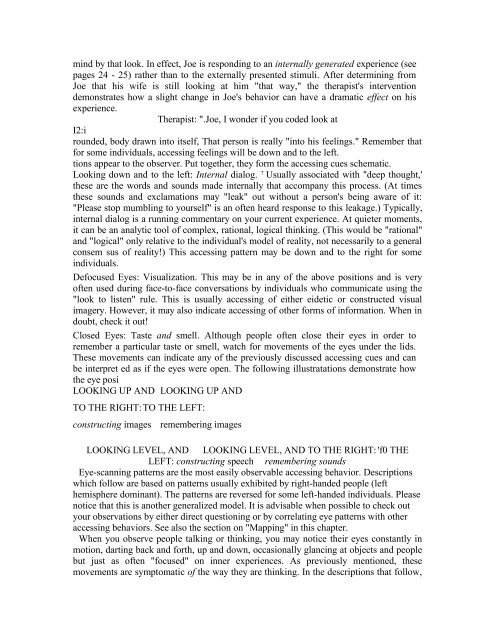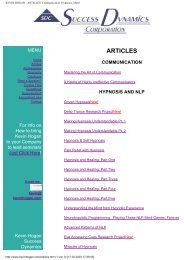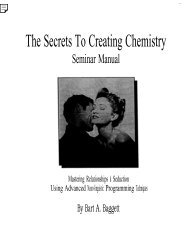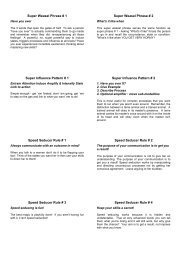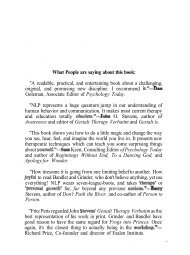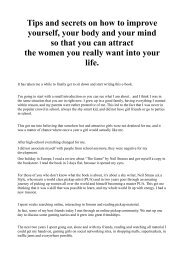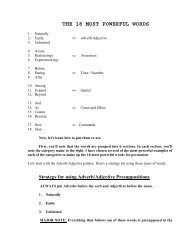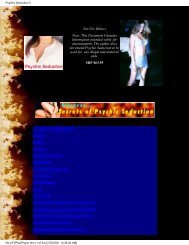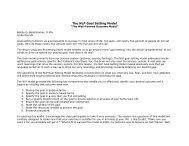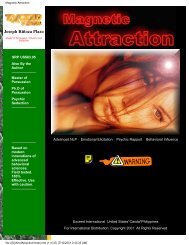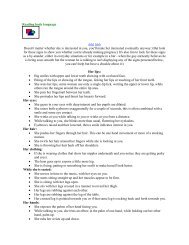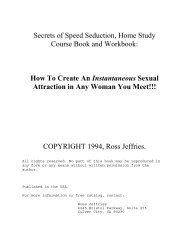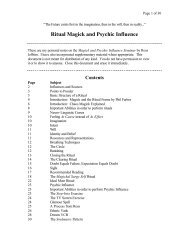A Pragmatic Guide To Communication & Change.pdf - NLP Info Centre
A Pragmatic Guide To Communication & Change.pdf - NLP Info Centre
A Pragmatic Guide To Communication & Change.pdf - NLP Info Centre
- No tags were found...
Create successful ePaper yourself
Turn your PDF publications into a flip-book with our unique Google optimized e-Paper software.
mind by that look. In effect, Joe is responding to an internally generated experience (see<br />
pages 24 - 25) rather than to the externally presented stimuli. After determining from<br />
Joe that his wife is still looking at him "that way," the therapist's intervention<br />
demonstrates how a slight change in Joe's behavior can have a dramatic effect on his<br />
experience.<br />
Therapist: ".Joe, I wonder if you coded look at<br />
I2:i<br />
rounded, body drawn into itself, That person is really "into his feelings." Remember that<br />
for some individuals, accessing feelings will be down and to the left.<br />
tions appear to the observer. Put together, they form the accessing cues schematic.<br />
Looking down and to the left: Internal dialog. 7 Usually associated with "deep thought,'<br />
these are the words and sounds made internally that accompany this process. (At times<br />
these sounds and exclamations may "leak" out without a person's being aware of it:<br />
"Please stop mumbling to yourself" is an often heard response to this leakage.) Typically,<br />
internal dialog is a running commentary on your current experience. At quieter moments,<br />
it can be an analytic tool of complex, rational, logical thinking. (This would be "rational"<br />
and "logical" only relative to the individual's model of reality, not necessarily to a general<br />
consem sus of reality!) This accessing pattern may be down and to the right for some<br />
individuals.<br />
Defocused Eyes: Visualization. This may be in any of the above positions and is very<br />
often used during face-to-face conversations by individuals who communicate using the<br />
"look to listen" rule. This is usually accessing of either eidetic or constructed visual<br />
imagery. However, it may also indicate accessing of other forms of information. When in<br />
doubt, check it out!<br />
Closed Eyes: Taste and smell. Although people often close their eyes in order to<br />
remember a particular taste or smell, watch for movements of the eyes under the lids.<br />
These movements can indicate any of the previously discussed accessing cues and can<br />
be interpret ed as if the eyes were open. The following illustratations demonstrate how<br />
the eye posi<br />
LOOKING UP AND LOOKING UP AND<br />
TO THE RIGHT:TO THE LEFT:<br />
constructing images<br />
remembering images<br />
LOOKING LEVEL, AND LOOKING LEVEL, AND TO THE RIGHT: 'f0 THE<br />
LEFT: constructing speech remembering sounds<br />
Eye-scanning patterns are the most easily observable accessing behavior. Descriptions<br />
which follow are based on patterns usually exhibited by right-handed people (left<br />
hemisphere dominant). The patterns are reversed for some left-handed individuals. Please<br />
notice that this is another generalized model. It is advisable when possible to check out<br />
your observations by either direct questioning or by correlating eye patterns with other<br />
accessing behaviors. See also the section on "Mapping" in this chapter.<br />
When you observe people talking or thinking, you may notice their eyes constantly in<br />
motion, darting back and forth, up and down, occasionally glancing at objects and people<br />
but just as often "focused" on inner experiences. As previously mentioned, these<br />
movements are symptomatic of the way they are thinking. In the descriptions that follow,


